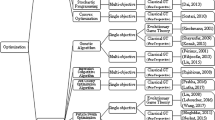Abstract
The market sharing problem was proposed by M. Dawande and G. Cornuéjols (INFORMS J. Comput. 11, 1999) to compare the performance of linear integer programming algorithms. Haibo Wang (Manuscript No. 251, Annuals of Operations Research, 2008) examined some hard instances of these problems and reported the results he obtained with the commercially available program CPLEX.
This paper first describes a model, which allows to embed integer programs with inequalities into a lattice and then reports the progress with Wang’s instances, by using a lattice based algorithm which employs a new heuristical sieving procedure. These results are compared to recent CPLEX 12.0 benchmarks.
Similar content being viewed by others
References
Aardal, K., Hurkens, C., & Lenstra, A. K. (1998). Solving a system of diophantine equations with lower and upper bounds on the variables. In Springer lecture notes in computer science: Vol. 1412. Integer programming and combinatorial optimization 6.
Babai, L. (1986). On Lovàsz lattice reduction and the nearest lattice point problem. Combinatorica, 6, 1–13.
Cornuéjols, G., & Dawande, M. (1999). A class of hard small 0–1 programs. INFORMS Journal on Computing, 11, 205–210
Coster, M. J., Joux, A., LaMacchia, B. A., Odlyzko, A. M., & Schnorr, C. P. (1992). Improved low-density subset sum algorithms. Computational Complexity, 2, 111–128.
Euchner, M., & Schnorr, C. P. (1994). Lattice basis reduction: improved algorithms and solving subset sum problems. Mathematical Programming, 66, 181–199.
Lenstra, A., Lenstra, H. W., & Lovász, L. (1982). Mathematische annalen: Vol. 261. Factoring polynomials with rational coefficients. Berlin: Springer.
Nguyen, P. Q., & Vidick, T. (2008). Sieve algorithms for the shortest vector problem are practical. Journal of Mathematical Cryptology, 1, 181–207.
Martello, S., & Toth, P. (1990). Knapsack problems: algorithms and computer implementations (pp. 108–109). Chichester: Wiley.
Schnorr, C. P. (1987). A hierarchy of polynomial time lattice basis reduction algorithms. Theoretical Computer Science, 53, 201–224.
Sierksma, G. (1996). Pure and applied mathematics. Linear and integer programming: theory and practice (pp. 254–263). New York: Dekker.
Vogel, H. (2011). Gitterbasenreduktion mit Random Sampling und heuristischen Erweiterungen. Ph.D. thesis, submitted at the University of Bayreuth.
Wang, H. (2008). A note on solving the market split problem via branch-and-cut (Manuscript No. 251). Annuals of Operations Research.
Wassermann, A. (2002). Attacking the market split problem with lattice point enumeration. Journal of Combinatorial Optimization, 6, 5–16.
Williams, H. P. (1978). Model building in mathematical programming. New York: Wiley.
Acknowledgement
I would like to thank PD Dr. Alfred Wassermann for his helpful remarks and the contributions to the (RIP) formulation.
Author information
Authors and Affiliations
Corresponding author
Appendix
Appendix
The discovered solutions and the benchmark files can be downloaded from: http://www.birdworx.de/math/dld/benchmark.tar.gz The archives containing the benchmark files, which were used by H. Wang in his comparison can be downloaded from: http://www.tamiu.edu/~hwang/research/marketshare/ For the benchmarks H. Wang employed the commercial program package CPLEX in version 10.0. His benchmark times and the results which were obtained with the newer 12.1 release are also listed in the tables. As the standard settings of the new version outperformed Wang’s special settings, the default settings were left untouched.
The special settings H. Wang (2008) used for his CPLEX10 benchmarks were:
-
set preprocessing presolve y
-
set preprocessing repeatpresolve 3
-
set mip strategy lbheur y
-
set mip strategy rinsheur 30
-
set mip strategy nodeselect 2
-
set mip strategy variableselect 3
For being able to compare the performance of RASA with CPLEX, the benchmarks files have to be converted to a compatible file format, which is accomplished with the following UNIX commands:

Remark 2
The helper tools lp2prb and prb2lat are part of the RASA package and can be obtained from the author.
Rights and permissions
About this article
Cite this article
Vogel, H. Solving market split problems with heuristical lattice reduction. Ann Oper Res 196, 581–590 (2012). https://doi.org/10.1007/s10479-012-1143-0
Published:
Issue Date:
DOI: https://doi.org/10.1007/s10479-012-1143-0




